
This cluster was led by the two of us
as well as Adam Menges of Lobe.ai and Microsoft,
and by Samantha Walker of SOM.
This work was supported by Lobe.ai,
by SOM,
and by the SG organization.
Good afternoon.
I'm Kat Park,
emerging technology leader at SOM
and this is Kyle Steinfeld,
Associate Professor of Architecture
at UC Berkeley.
We'd like to talk today
about some work related to a cluster
we helped to lead
at the 2018 Smart Geometry Conference
held in Toronto.

This cluster was led by the two of us
as well as Adam Menges of Lobe.ai and Microsoft,
and by Samantha Walker of SOM.
This work was supported by Lobe.ai,
by SOM,
and by the SG organization.
While we will present the work
completed by this workshop cluster momentarily,
we'd like to begin with a brief discussion
of the thinking that produced it.
This was a year ago,
which feels like a decade
considering how intense and quickly
things have been progressing in the ML world.
A year ago,
we came up with a strategy
to test one model
of integrating ML
into creative computational architectural design.
It was one model,
which quickly forked
into other directions during the workshop
as well as by others
in the field during the past year.
As we have seen
in previous moments
in the history of design technology,
the early stages
in the adoption of a new technology
is often marked
by intense periods
of experimentation
and disruptions of existing technical and social frameworks.
Clarity is not easy to come by in such moments;
Those who seek certainty in these times
are quickly humbled.
---------------------
While we will present the work completed by this workshop cluster momentarily, we'd like to begin with a brief discussion of the thinking that produced it.
In short,
this cluster sought to test one model
for the integration of Machine Learning
and Creative Computational Architectural Design:
a model that has continued to bear fruit
over the past year.
However,
it should be noted that
we tested just one model
for this integration.
Given the nature of our current moment
of intense interest
and impressive progress
in Artificial Intelligence generally,
we can be sure that this one model
for integrating ML and design practice
will not stand alone.
As we have seen in previous moments
in the history of design technology,
the early stages in the adoption of a new technology
is often marked by
intense periods of experimentation
and disruptions of existing technical and social frameworks.
Clarity is not easy to come by in such moments;
Those who seek or who claim to have found certainty
in these times are quickly humbled.

After briefly outlining our framework
for the application of Machine Learning to design,
we'll offer a number of examples
that both demonstrate its usefulness and its limits.
These examples
are drawn primarily
from the proposals of participants in the workshop
but also from other relevant projects
that have been developed independently since SG.
We'll begin with Kyle Steinfeld
who will briefly outline the framework
that guided our work.
---------------------
And so,
in the interest of humility,
after briefly outlining our framework
for the application of AI to design,
we'll offer a number of examples
that both demonstrate its usefulness and its limits.
These examples are drawn primarily from
the proposals of participants in our cluster
(as described in our paper)
but also from other relevant projects
that have been developed independently.
[KYLE]
It will come as no surprise
to anyone in this room
that machine learning
has made rapid gains
in recent years.
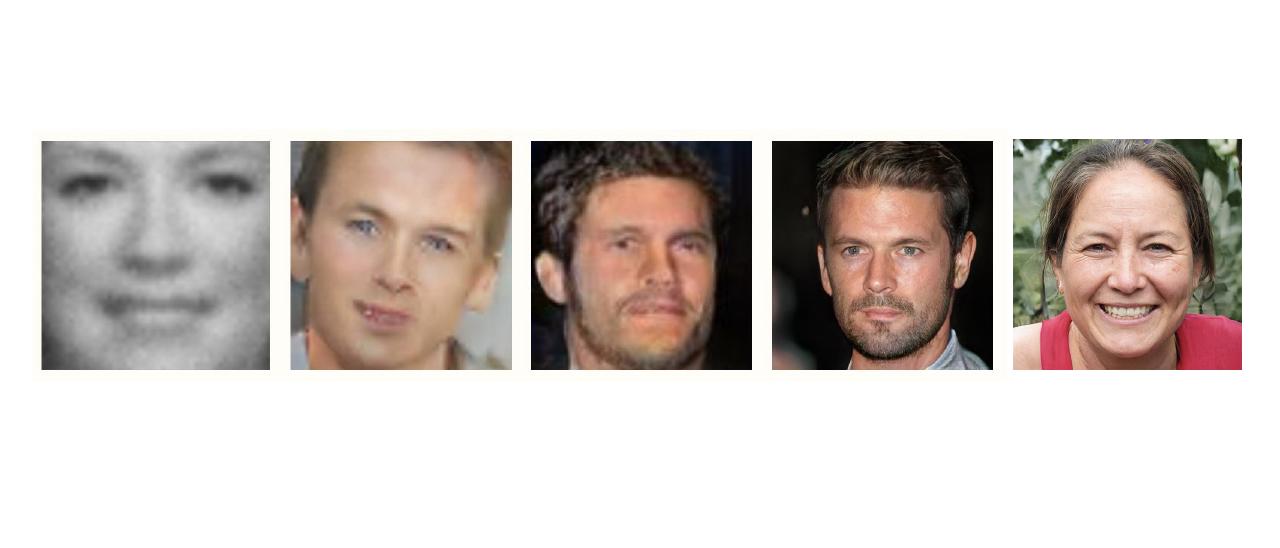
From left to right:
Goodfellow et al (2014), Radford et al (2015), Liu and Tuzel (2016), Karras et al (2017), Karras et al (2018)
Adapted from General Framework for AI and Security Threats
As clearly demonstrated by this sequence of images.
For those not familiar,
what might not be readily apparent
is that each of these images was generated by a computer,
not as the manipulation of an existing photo,
but rather as an entirely new form
that matches an existing pattern of known forms
drawn from experience.
These are images that the computer has "drawn", on its own.

Synthetic Faces generated by StyleGAN.
Images generated by thispersondoesnotexist.com
The thought of being able to train a computer
to synthesize images,
to "draw" pictures
with such fidelity,
... this is more than a little jarring.
However,
taken from a creative authorship point of view,
it is also quite inspiring.

At least it is to me...
I first studied architecture in the 1990s,
when drawing as an activity was in transition
from analog things,
like pencil and vellum,
to basic digital media
which seemed at the time
to be very different.
at that time,
the mode of authorship
enabled by analog drawing tools
appeared to be a straightforward affair.
this is a mode
that remains well described
by what I now understand as
the 'reflective loop' of design activity

despite all the changes brought about
by the digital transformation
of the early 2000's
this understanding of design activity
as an iterative cycle of making and seeing
basically held true
even as computers offered new forms of acting
from working indirectly on the shape of curves via control points
to assembling ornate chains of logic via scripting
this model more-or-less held its ground,
and the "seeing" that is so crucial to design,
was left to us humans.

in the late 2000s,
the advent of parametric modeling
changed things slightly

a new form of design action
found its way into practical application
one that formalized
not only computational modes of acting,
but also replaced
the direct visual evaluation of humans
with the formalized evaluation routines
of machines.
this design method,
novel in the early 2000s,
has come to be known as
"generative design"

Generative Design in architecture
is widely understood
as a three-stage cycle:
in the generation step,
new potential forms are proposed
using a computational process.
in the evaluation step,
the performance of these forms are quantified
again relying on computational analysis
rather than the subjective eye of the designer
and in the iteration step,
parameters of generation are manipulated
to find better results.
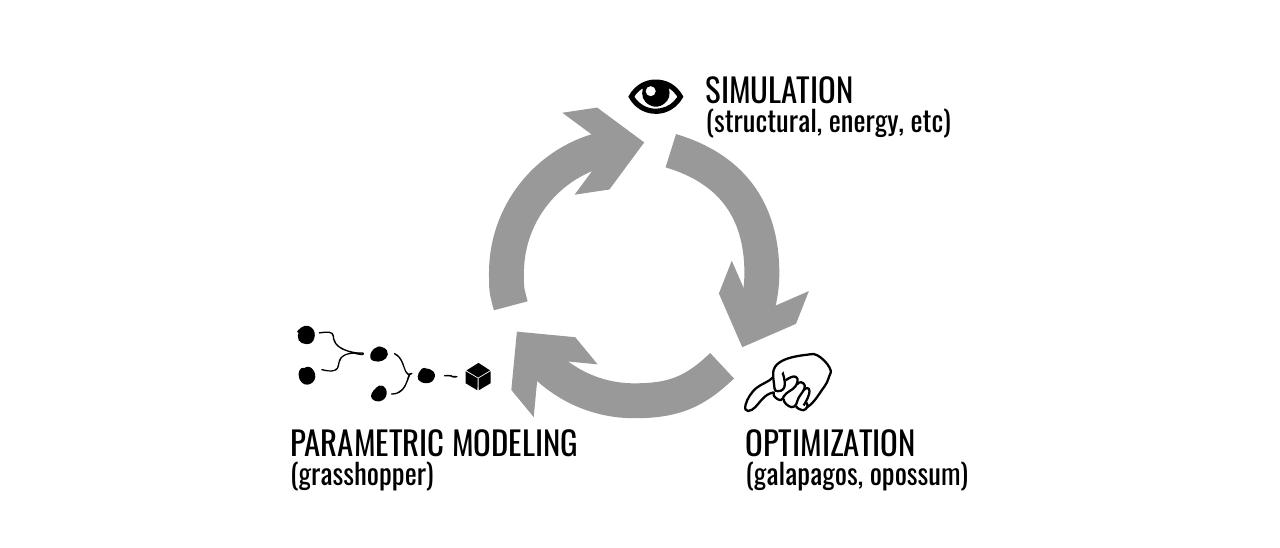
This approach typically employs
a combination of
parametric,
simulation,
and optimization tools.
this is where the contribution of the cluster,
in synthesizing ML
and Generative Design,
comes into play.
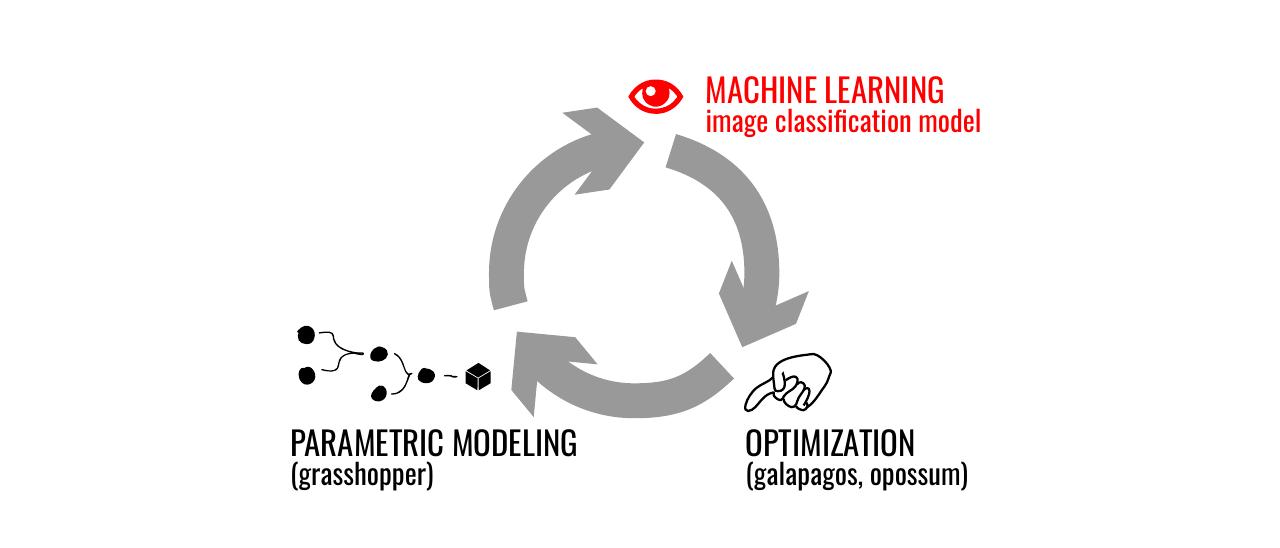
This cluster proposed a modest modification
of the generative design process.
We swap out the evaluation step of the cycle
which is typically the domain
of architectural simulation
for a machine learning process,
specifically
a neural net
trained on image classification tasks
of one form or another
So, for the uninitiated,
what is ML?
and how can it participate this process?
While we'll likely hear a lot about ML today,
I'll take this chance to offer
my favorite definition:
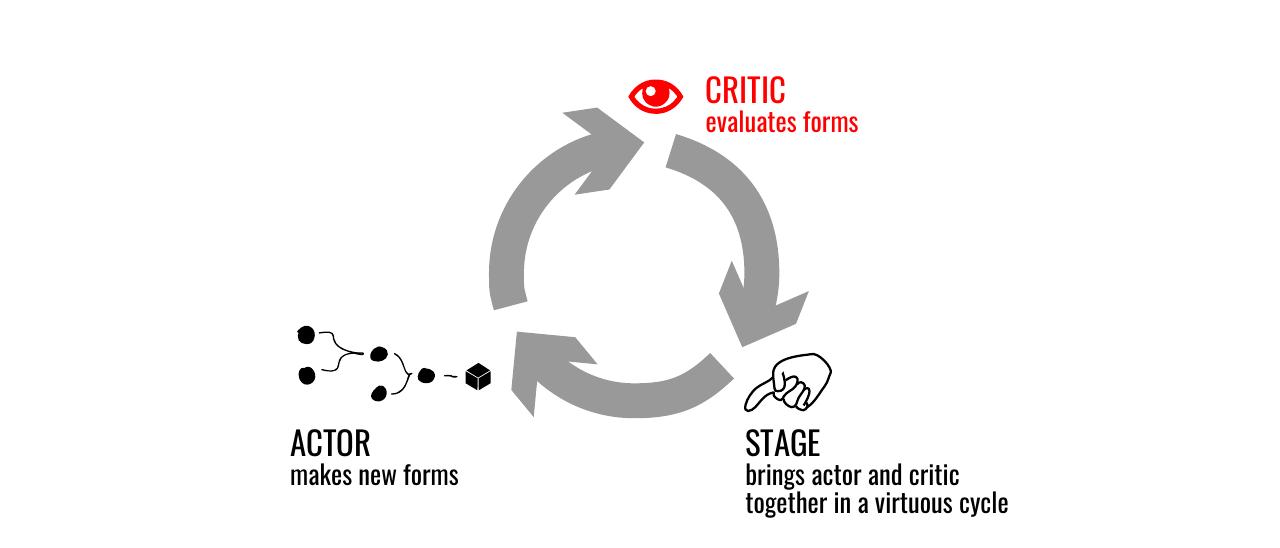
This process is different enough
from traditional methods for evaluation,
as to warrant an adjustment
of the **terms** of generative design.
And so,
our cluster re-defines the generative design cycle
as: actor, critic, stage.

As before,
an actor generates new forms,
and describes them
in a format preferred by ML
This issue of format
is a crucial one.
For a variety of reasons,
the most developed ML models
relevant to architectural design
operate on images.
For this reason,
we are content for now
to insist that our actor
re-present architectural form
as image
And so,
one important contribution of the cluster
involves the developing of methods
for **describing architectural forms and spaces as images**
in ways that allow the salient qualities
of form and space
to be captured by our critic

Moving on the evaluation step,
we define a critic
as a process that evaluates forms
based on patterns and types
learned from experience.
I should emphasize that
the importance of training a critic
should not be underestimated.
This is an important new locus
of creative action in design,
An important new form of subjectivity.
To cede this space
to existing processes and models
would be a huge loss for architectural design.
To secure
this new locus of subjectivity,
and to offer participants
the capacity to train their own models,
we partnered with a company called Lobe.ai
which sponsored our cluster
Lobe provided an essential platform
for training ML models
relevant to architectural evaluation.
As we see here,
Lobe is a web-based visual tool for
constructing models
for training them
and for allowing them to serve up predictions
An anlaogy might be helpful:
as Grasshopper is to Rhino
so Lobe is to Tensorflow

Finally, we define a stage.
The stage is the system
which brings together actor and critic,
allowing an actor
to progressively improve her performance.
Here,
traditional optimization techniques are employed,
which I'm sure all of us in the room
hold a rough understanding of.
So,
to illustrate how these pieces go together,
we see in this animation an actor and critic
coming together on a stage.
Here,
a critic is trained on 3d models that describe
typologies of detached single-family homes
cape cod house
shotgun
dogtrot
etc..
The job of the critic
is to evaluate the performance of an actor,
In this case,
our actor generates house-like forms,
such as the ones we see flashing by
in this animation.
These two intelligences
are brought together in an optimization,
wherein the actor
generates new potential house forms,
these forms are scored by the critic
in terms of how much they resemble
a known type of house,
such as the California Eichler style
shown here
and then the process iterates
in a classic optimization.
and so,
by modestly adjusting
the nature of the evaluation step
of the generative design process,
we find a way forward
from optimizing for **quantifiable objectives**,
as is typical in generative design
to optimizing for more **qualitative objectives**,
such as architectural typology
or spatial experience
These qualitative objectives
need not be strictly rational.
They might be more whimsical,
as demonstrated by the Actor-Critic relationship
shown in this animation.
Here,
an actor that generates balloon-like forms
separately attempts to please two critics:
one that prefers zucchinis,
and a second that prefers bananas.
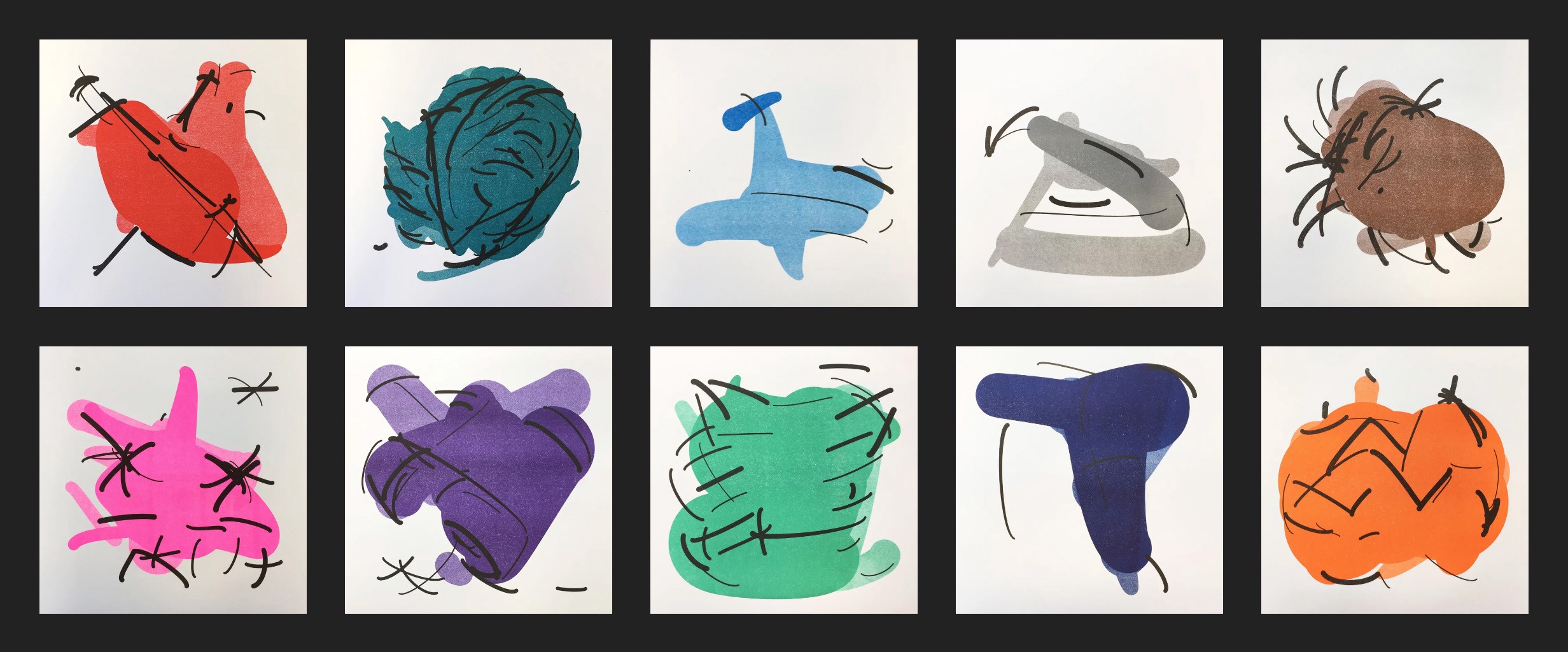
So this is the framework
that was introduced to cluster participants,
who, over the course of the four-day workshop,
probed
extended
exploded and re-assembled
this framework toward a variety of individual ends.
I'm going to talk about some of the applications of this framework that was explored at the workshop.

One of the most interesting value ML offers to the design world is its ability to embody Quali - things we can't quite describe with words (and therefore script into explicit code) and as designers we are constantly thinking imagistically and qualitatively.
Some of the workshop participants wanted to craft an optimization that speaks to this experiential concept, such as what it feels like to occupy various types of forests. This particular project here extended our isovist representation to attempt to capture the spatial experience of scale.

There are experiments by others who used ML to capture the intangible - like styles of art and architecture. These are a bit easier since they are artists with distinct styles and we have numerous data but I think the next step is to try to embody the critique that designers engage in, such as what makes a space work or a plan that has a nice flow.
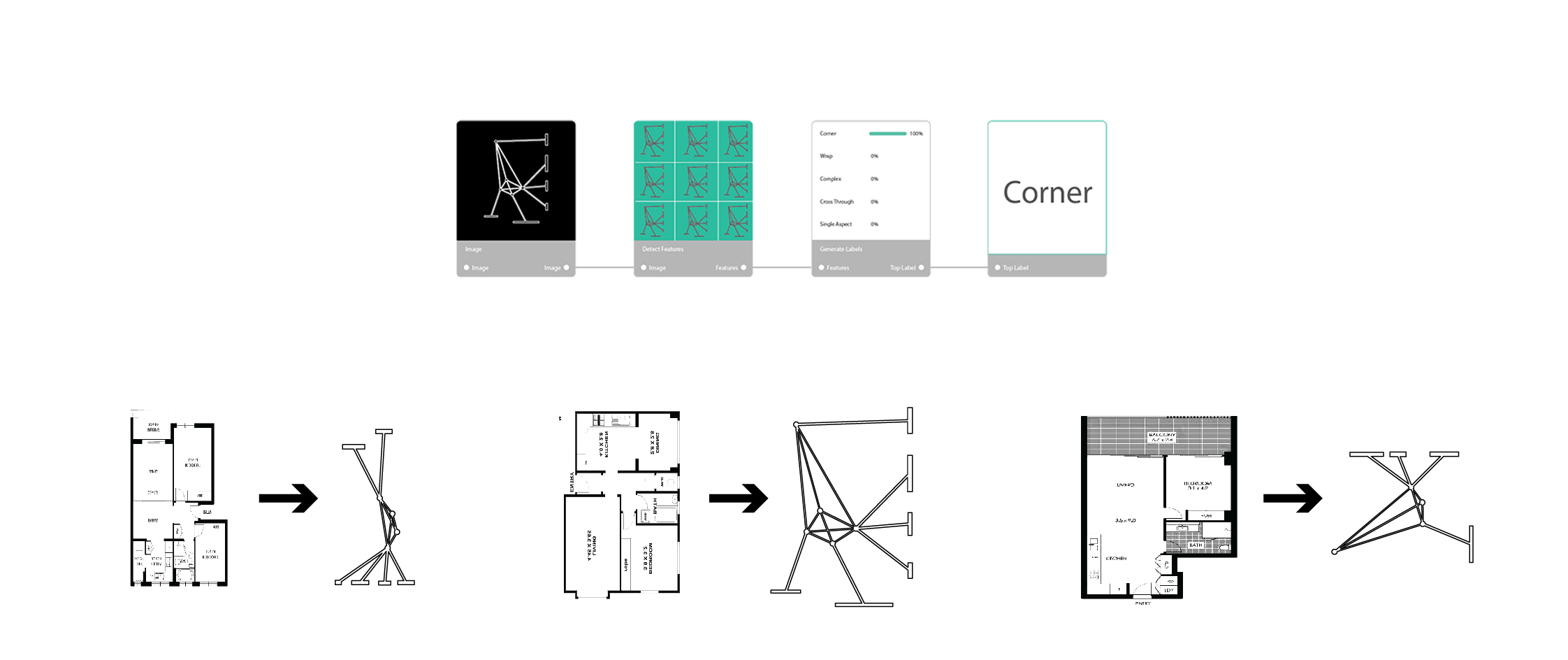
the work we see here
took a deep dive into feature detection
in images of floor plans
with the goal of
eventually generating these graphics
artificially
Stanislas Chaillou 2019
This is a clear initial application of ML in design that many are attempting in architecture - but since the image of our plans are a representation of the final product, not actually the final product in the way art or music is, there is an extra step necessary to make ML actually relevant here. The symbolic representations we use in plans is coded as colors in this example from GSD which allows the ML algorithms to translate those colors to different objects or spaces.
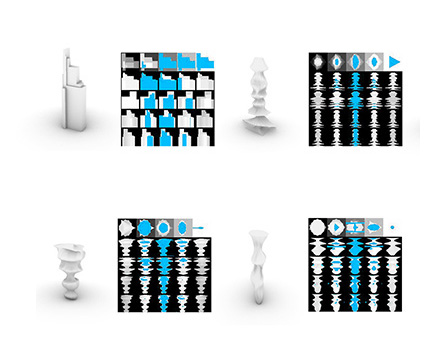
Some participants were interested in
focusing just on a configuration of an actor,
pitting a parametric model that they made
against an existing critic,
in this case one that was trained to predict
the performance of tower forms under wind loads
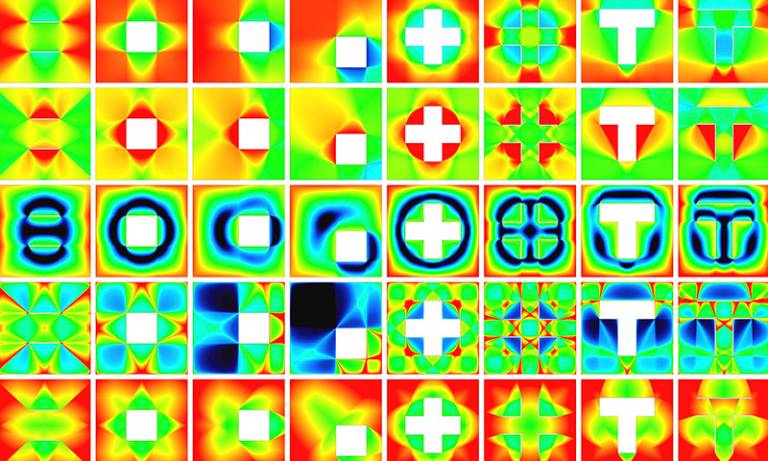
Replacing a time-consuming or costly simulation
with a trained ML model
is another popular direction that people are looking into
here you see CFD analysis results that were used as training sets but there are others doing the same with EUI prediction.
These are all simulations that have a large impact on the design in practice, especially early on but take longer to generate so by the time results are returned, the designers have moved on.
With trained Machine Learning model an API call away, people in practice are trying to reduce this time factor hurdle.
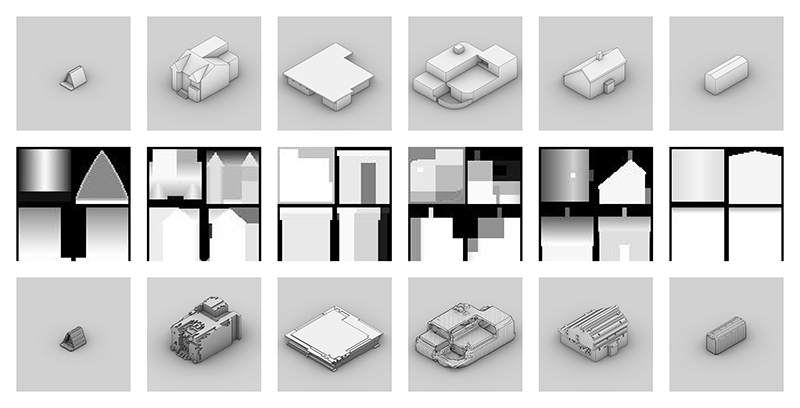
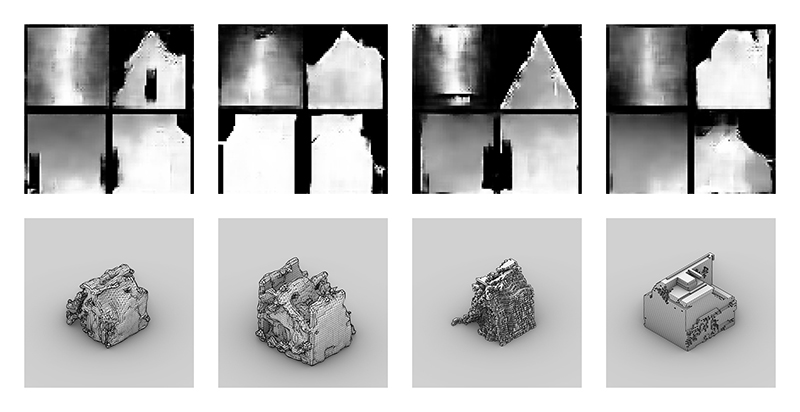
to conclude,
another group was interested
in better understanding
how our critics "see" architectural form
and how this is different
from the way we see it.
to explore this question,
they "reverse engineered"
our raster representations of form
back to three-dimensional form
which validated that what the ML algorithm sees
is actually quite similar to what we see.

this work enabled an entirely new approach based on a Generative Adversarial Network or "GAN"
In short, a GAN replaces not just the evaluation step, but the generative step as well, such that actor and critic are both ML models.
Kyle Steinfeld, 2018
Shown at the NeurIPS 2018 Machine Learning for Creativity and Design
www.aiartonline.com/design/kyle-steinfeld/